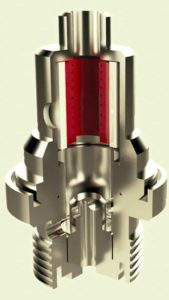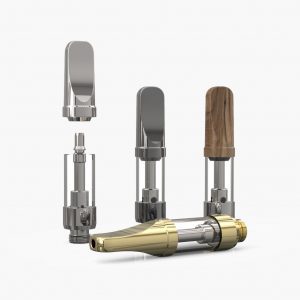Posted by Derek Champoux
4 years ago / April 26, 2020
Vape Hardware Materials, Ranked


Taking the bus to work has the same ultimate result as driving a Rolls-Royce, but the experience is entirely different.
The same is true for cannabis vape pens: while the effects of vaping the same extract may be the same when using different hardware, consumers’ experiences and enjoyment levels vary depending on the different materials built into each device. We take a look at the best and worst vape hardware material options available on the market today.
Metals
Nothing beats food-grade stainless steel when selecting the materials for the metal components in your hardware that contact your extract. The material retains its strength and durability at high temperatures and is resistant to scaling, corrosion, and the type of wear-and-tear damage that comes with everyday use.
Food-grade stainless steel is one of the safest and most relied-upon, non-allergenic metals in the world, found commonly in surgical tools, jewellery, pet dishes, and kitchen utensils. Greentank uses SUS-303 stainless steel for all of its oil-touching metal components, including its center posts.
Nickel-plated brass is another option for your metallic hardware components. Like stainless steel, it too is corrosion-resistant and can withstand high temperatures, but it is nowhere near as safe to ingest. The brittle material is known to leach heavy metals into extracts and flake over time when treated with certain surface finishes, including electroplating.
Some plastics are suitable alternatives at lower temperature ranges to stainless steel, provided they can withstand high temperatures and are resistant to corrosion. Greentank uses food-safe plastics, including PETG and PCTG, in some of its disposable devices. Cheaper plastics that cannot withstand high temperatures and are not resistant to corrosion are unfit for vape hardware.
Many of these cheaper plastics are not structurally sound and can release BPAs, a harmful carcinogen linked to heart disease and infertility when heated at certain temperatures.
Core Materials
 Coils have replaced wicks as the go-to core heating technology for cannabis vape hardware, but there are some major differences between the two predominant coil options on the market today: ceramic and quartz.
Coils have replaced wicks as the go-to core heating technology for cannabis vape hardware, but there are some major differences between the two predominant coil options on the market today: ceramic and quartz.
Ceramics are the industry’s preferred coil material for several reasons. They offer superior heat retention than quartz coils, while delivering more robust flavor profiles and consistent vapor. They’re also less of a drain on your batteries. The two most common drawbacks to ceramic coils are that they take longer to heat up than quartz coils and are more susceptible to cracking at higher temperatures, but Greentank has solved these issues in two ways:
- By triple-baking its proprietary Ceramic Core Technology at 1000˚C to eliminate impurities and reinforce the material
- By creating a line of proper 510-thread-compatible batteries that provide optimized, even heating to our coils.
Quartz coils, on the other hand, heat up more efficiently than ceramics and deliver pure flavors but they retain heat rather poorly and burn through batteries rapidly. Their temperature controls are also less accurate than ceramics, making them a poor choice for low-viscosity oils and extracts. Although quartz coils deliver thick and robust vapor, it tends to be on the harsher side—a quality that most beginners and intermediates tend to not enjoy when trying different devices.
Glass
Borosilicate glass comprises most high-quality labware, including beakers and test tubes, and it’s with good reason that scientists put so much faith in this material. The glass is resistant to both thermal shock and the expansion that can cause other glasses to break or deteriorate when heated. As well, borosilicate glass offers greater clarity of vision for users to see your extract. All Greentank cartridges are composed of borosilicate glass.
 Resin glass is the next best option, although it’s technically an acrylic. Commonly used for wristwatches, this material is low-cost and light-weight but not particularly temperature resilient or resistant, making it prone to scratches and other surface scuffs.
Resin glass is the next best option, although it’s technically an acrylic. Commonly used for wristwatches, this material is low-cost and light-weight but not particularly temperature resilient or resistant, making it prone to scratches and other surface scuffs.
Lesser quality glasses, such as soda-lime glass (which comprises approximately 90% of manufactured glass), are a poor choice for vape pen reservoirs. Soda-lime glass has half the thermal resistance of borosilicate glass and is prone to breaking when heated. Other glasses, such as lead glass, also run the risk of dangerous metals leaching into the extracts when exposed to heat.
Premium Vape Pens for Cannabis Retailers & Producers
Getting vape pens made with premium materials not only creates a safer, more consistent product, it also means giving your customers a vape experience that will keep them coming back. Let your customers enjoy your extracts the way you intended using the safest hardware on the market by contacting Greentank today.
Filed Under:
Interested in our products?
Contact us to find out how you can carry the most reliable vape hardware solutions on the market.
General Requests
Logistics
